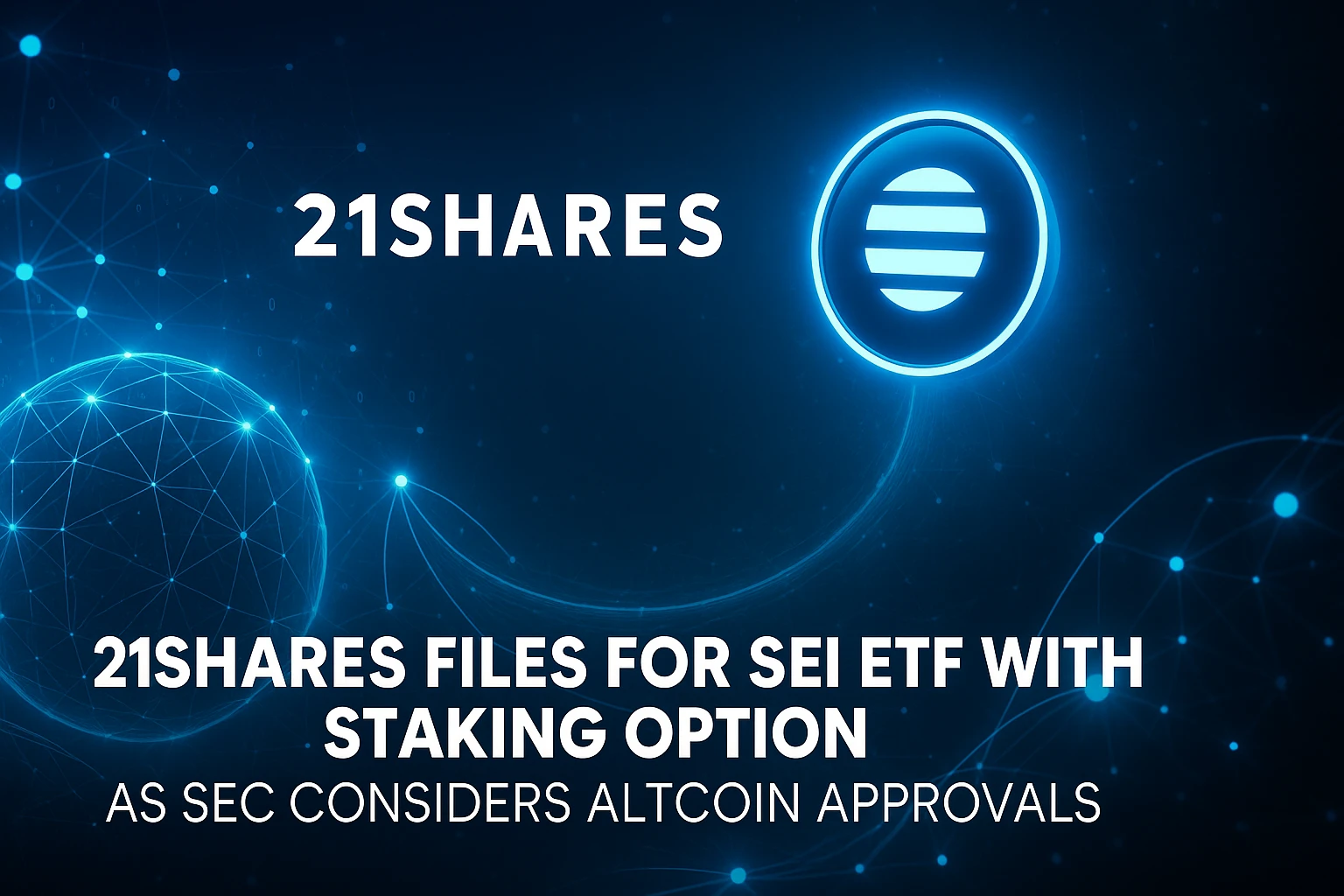21Shares Files For SEI ETF with Staking Option as SEC Considers Altcoin Approvals

Crypto asset manager 21Shares has formally entered the race to launch a regulated exchange-traded fund tied to the Sei (SEI) token, filing a Form S-1 registration statement with the US Securities and Exchange Commission (SEC) on August 28, 2025.
- Competition Heats Up Between 21Shares and Canary Capital
- Regulatory Backdrop Shapes the ETF Race
- How the SEI ETF Would Work in Practice
- Staking Language and Delegated Proof of Stake Implications
- Market Reaction and Price Movement
- Global Context: Europe’s SEI ETP Sets the Stage
- Why Sei’s Design Matters for Institutional Investors
- Industry Voices Highlight Significance of the Filing
- Key Facts at a Glance
- What Comes Next in the Approval Process
- Conclusion: A Test Case for Altcoin ETFs
- Frequently Asked Questions about 21Shares SEI ETF
- What is the 21Shares SEI ETF?
- How does the SEI ETF use Delegated Proof of Stake?
- Who will have custody of the assets for the SEI ETF?
- How does this ETF compare with Canary Capital’s proposal?
- When could the SEI ETF be approved?
- Glossary of Key Terms
The proposed ETF would hold SEI directly, track the CF SEI Dollar Reference Rate (New York Variant) as its benchmark, and employ Coinbase Custody Trust Company as custodian.
The filing emphasizes that the ETF is designed as a passive, physically backed product. It excludes leverage and derivatives, instead offering pure exposure to SEI’s spot price. Yet one feature makes this application distinct: 21Shares left the option open to stake a portion of its SEI holdings.
If approved, staking rewards would be reflected in the net asset value of the fund—a potential first for US ETFs tied to Delegated Proof of Stake (DPoS) networks.
For investors, that conditional clause matters. It means that a future SEI ETF could not only provide regulated access to a fast-growing blockchain token but also channel staking yields that come from validators securing the SEI network.
ALSO READ: ARK Invest’s Stake in BitMine Surges Beyond $300M as Ether Treasury Model Gains Traction
Competition Heats Up Between 21Shares and Canary Capital
The SEI filing does not exist in isolation. Earlier this year, Canary Capital submitted its own proposal for a staked SEI ETF, with staking framed as a core feature rather than a conditional option. The two products now represent competing visions of how altcoin ETFs should look in the United States.
Canary has pitched its fund as a yield-bearing product, giving investors direct access to the staking returns generated on Sei’s Delegated Proof of Stake system.
21Shares, by contrast, has taken a more cautious stance, highlighting the possibility of staking but subordinating it to legal, tax, and regulatory clarity.
The divergence illustrates a broader strategic divide among issuers. Some view staking yield as the natural evolution of crypto ETFs, while others prefer to win regulatory approval first and experiment later. For investors, the competition presents a clear choice between risk-averse and compliance-first strategies.
Regulatory Backdrop Shapes the ETF Race
The SEC’s attitude toward crypto ETFs has been cautious but evolving. Spot Bitcoin ETFs, approved in early 2024, broke the ice by allowing regulated access to BTC without derivatives. Ethereum ETFs followed soon after, marking a watershed moment for mainstream digital asset investment.
But altcoin ETFs are a different test. The SEC must evaluate factors such as custody, pricing benchmarks, liquidity, and risks of market manipulation.
Adding staking introduces further complexity. Rewards from DPoS systems vary depending on validator performance, delegation levels, and governance participation, issues that intersect awkwardly with US securities law.
That is why 21Shares’ wording matters. The filing stresses that staking will only be pursued if it poses “no undue legal, regulatory, or tax risk” and preserves the fund’s status as a grantor trust. In other words, staking is on the table, but the SEC has the final say.
There are signs the regulator may be open to quicker approvals. In August, SEC officials discussed the possibility of streamlining the review process, potentially shortening approval timelines to 75 days when filings meet standardized requirements. If that framework takes hold, funds like the 21Shares SEI ETF could face a far shorter road to market.
How the SEI ETF Would Work in Practice
The proposed 21Shares SEI ETF mirrors the structure of existing spot crypto products. The trust would:
- Hold SEI tokens in custody with Coinbase Custody.
- Value the fund daily using CF Benchmarks’ SEI Dollar Reference Rate.
- Allow authorized participants to create and redeem shares in large blocks known as creation units.
- Employ Coinbase, Inc. as a prime broker, with the option to use Coinbase Credit for short-term settlement needs.
Importantly, the ETF would not trade derivatives or futures. Instead, it would simply reflect SEI’s price movements, providing a regulated on-ramp for investors who prefer to avoid the risks of self-custody or unregulated exchanges.
Staking Language and Delegated Proof of Stake Implications
The optional staking provision is the most notable innovation in the filing. SEI runs on a Delegated Proof of Stake consensus mechanism. In this model, token holders delegate SEI to validators who produce blocks, validate transactions, and share staking rewards.
For a regulated ETF, participation in DPoS could provide investors with additional returns beyond price appreciation. However, it also introduces operational and compliance challenges. A fund must decide which validators to delegate to, ensure neutrality in governance participation, and safeguard against concentration risks that could undermine network security.
21Shares has hedged against these risks by stating that it may employ third-party staking providers or use liquid staking tokens, if legally permissible. By keeping the decision discretionary, the sponsor avoids binding itself to a feature that could complicate SEC approval.
Market Reaction and Price Movement
Markets responded quickly to the news. SEI’s price rose from roughly $0.29 to $0.31 after the filing, and 24-hour trading volume surged above $250 million. While modest in absolute terms, the reaction demonstrated how ETF headlines continue to serve as liquidity catalysts for altcoins.
The response mirrored earlier patterns seen with Bitcoin and Ethereum ETFs, where filings and approvals significantly moved underlying asset prices. Even without approval, the signal of institutional interest often spurs speculative demand.
ALSO READ: USDC Expansion to XDC Network Boosts Circle as TRON Slashes Transaction Cost by 50%
Global Context: Europe’s SEI ETP Sets the Stage
The US is not the first jurisdiction to consider regulated SEI products. In July, CoinShares launched the CoinShares Physical Staked SEI (CSEI) in Europe, touting zero management fees and a 2% staking yield. That launch gave investors their first taste of regulated SEI exposure and demonstrated that demand exists.
Europe’s willingness to incorporate staking directly contrasts with the more cautious approach in the US. If 21Shares succeeds, it would close the gap and potentially position the US market for broader experimentation with staking-enabled ETFs.
Why Sei’s Design Matters for Institutional Investors
Sei is not just another blockchain token. Launched in 2023, it is a Cosmos-based Layer 1 blockchain optimized for high-speed trading. Its infrastructure supports decentralized exchanges, marketplaces, and applications requiring low latency and high throughput.
Sei’s DPoS consensus model allows it to scale effectively while maintaining strong security guarantees. Token holders who delegate to validators not only help secure the network but also participate indirectly in governance. This governance-by-delegation dynamic is one reason why SEI is seen as more institution-friendly than fully permissionless alternatives.
For institutional investors, the appeal of an SEI ETF is twofold: exposure to a rapidly growing trading-focused blockchain and potential access to staking yields without navigating complex wallet setups.
Industry Voices Highlight Significance of the Filing
The SEI ETF filing generated immediate buzz across industry analysts and the crypto community:
BREAKING: 21Shares files S-1 with SEC to issue a SEI ETF. pic.twitter.com/eJDlPTjS75
— Sei (@SeiNetwork) August 28, 2025
- James Seyffart (Bloomberg Analyst): “Another crypto ETF filing. This time SEI. The product pipeline keeps growing.”
NEW: Here is a list of all the filings and/or applications I'm tracking for Crypto ETPs here in the US. There are 92 line items in this spreadsheet. You will almost certainly have to squint and zoom to see but best I can do on here pic.twitter.com/lDhRGEQBoW
— James Seyffart (@JSeyff) August 28, 2025
- Jay Jog (Sei Labs Co-founder): “Big moment for institutional access — Coinbase Custody named custodian in the SEI ETF filing.”
Congratulations to @21shares_us on filing for a Staked SEI ETF.
The filing names Coinbase Custody Trust Company as custodian, with Coinbase, Inc. as prime broker — underscoring the institutional infrastructure being assembled around Sei.
Coinbase Ventures is among the investors… https://t.co/CSSQnM4TzO
— Jay ($/acc) (@jayendra_jog) August 29, 2025
These voices highlight how ETF filings now serve as ecosystem milestones, validating the asset for both retail and institutional audiences.
Key Facts at a Glance
| Feature | Detail |
| Filing Date | August 28, 2025 |
| Sponsor | 21Shares US LLC |
| SEC Form | S-1 Registration Statement |
| Custodian | Coinbase Custody Trust Company |
| Prime Broker | Coinbase, Inc. |
| Benchmark | CF SEI Dollar Reference Rate (NY Variant) |
| Structure | Delaware Grantor Trust |
| Staking Option | Possible, subject to compliance |
| Competitor | Canary Capital Staked SEI ETF |
What Comes Next in the Approval Process
The SEC review will focus on familiar issues: custody security, benchmark reliability, surveillance-sharing agreements, and the tax implications of staking rewards. If new streamlined approval rules are implemented, decisions on altcoin ETFs could arrive much faster than in previous cycles.
Analysts estimate that by year’s end, the SEC could be evaluating over 100 digital asset ETFs, spanning not only Bitcoin and Ethereum but also Solana, XRP, and now SEI. The 21Shares filing indicates that issuers are placing significant bets on altcoin diversity as the next phase of ETF growth.
ALSO READ: Cardano and XRP Join Forces for Wider Multichain Global Adoption
Conclusion: A Test Case for Altcoin ETFs
The 21Shares SEI ETF represents more than just another filing. It serves as a litmus test for how regulators handle altcoin ETFs, indicating how far the SEC is willing to extend approvals beyond Bitcoin and Ethereum, and whether Delegated Proof of Stake rewards can ever be incorporated into a compliant US financial product.
Whether or not staking makes the final cut, the filing underscores the growing maturity of the crypto ETF market. It shows that altcoins are moving into regulated channels, and that issuers like 21Shares and Canary Capital are competing fiercely to establish first-mover advantage.
If approved, this 21Shares ETF could mark a turning point. It would prove that DPoS-based tokens are not only technically robust but also institutionally investable. That shift could open the floodgates for a new wave of blockchain assets to enter mainstream portfolios.
Frequently Asked Questions about 21Shares SEI ETF
What is the 21Shares SEI ETF?
The 21Shares SEI ETF is a proposed US exchange-traded fund designed to hold SEI tokens directly, track their spot price, and incorporate staking rewards.
How does the SEI ETF use Delegated Proof of Stake?
Sei operates on a Delegated Proof of Stake system, where token holders delegate tokens to validators. If staking is allowed, the ETF could channel rewards from this process into the fund.
Who will have custody of the assets for the SEI ETF?
Coinbase Custody Trust Company will hold the SEI tokens, while Coinbase, Inc. will serve as the prime broker.
How does this ETF compare with Canary Capital’s proposal?
Canary Capital’s version highlights staking as a central feature, while 21Shares frames staking as optional. Both aim to be first to market with a SEI ETF.
When could the SEI ETF be approved?
The SEC has not set a final timeline, but discussions suggest approvals for compliant products could come within 75 days under new streamlined rules.
Glossary of Key Terms
- Exchange-Traded Fund (ETF): An investment asset listed in stock markets and is connected to the performance of an index or a bond.
- SEI Token: The native token of the Sei blockchain, which is used for fees, staking, and governance.
- S-1 Filing: A registration form is a filing made to the SEC by companies intending to make a public offering.
- Delegated Proof of Stake (DPoS): A consensus system in which network participants who delegate assets to validators ensure network security.
- Staking: The process of locking tokens in a blockchain to assist in network security and gain rewards.
- Custodian: A controlled person who is charged with the responsibility of securing assets.
- CF Benchmarks: An indexing company that computes trusted crypto reference rates.
- Grantor Trust: A legal tax-efficient structure of crypto ETFs.
- Creation Units: ETF shares in large blocks formed by institutions or redeemed.
- Altcoin ETF: An ETF that is not a Bitcoin or Ethereum ETF.




